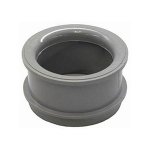bsw0
Member
- Location
- lexington, sc
NEC 300.15(C) requires a fitting where cables exit any conduit including non-metallic conduit. How does this apply to a service entrance where the conduit is used for physical protection only and terminates underground? What is the appropriate fitting to use for Schedule 80 PVC?
a) a male adapter and a threaded insulated bushing
b) an unthreaded insulated bushing for Rigid/IMC
c) a pvc box adapter and coupler
d) nothing at all, knock down the sharp edges
e) any of the above
f) none of the above
g)ask the POCO/AHJ because the NEC / UL Listing requirements are often superseded/ignored
a) a male adapter and a threaded insulated bushing
b) an unthreaded insulated bushing for Rigid/IMC
c) a pvc box adapter and coupler
d) nothing at all, knock down the sharp edges
e) any of the above
f) none of the above
g)ask the POCO/AHJ because the NEC / UL Listing requirements are often superseded/ignored


